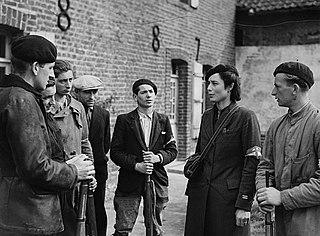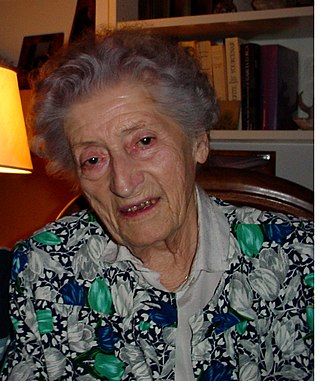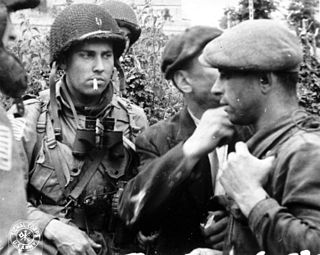
The Maquis were rural guerrilla bands of French and Belgian Resistance fighters, called maquisards, during World War II. Initially, they were composed of young, mostly working-class, men who had escaped into the mountains and woods to avoid conscription into Vichy France's Service du travail obligatoire which provided forced labor for Germany. To avoid capture and deportation to Germany, they became increasingly organized into active resistance groups.

The French Resistance was a collection of groups that fought the Nazi occupation and the collaborationist Vichy regime in France during the Second World War. Resistance cells were small groups of armed men and women who conducted guerrilla warfare and published underground newspapers. They also provided first-hand intelligence information, and escape networks that helped Allied soldiers and airmen trapped behind Axis lines. The Resistance's men and women came from many parts of French society, including émigrés, academics, students, aristocrats, conservative Roman Catholics, Protestants, Jews, Muslims, liberals, anarchists, communists, and some fascists. The proportion of French people who participated in organized resistance has been estimated at from one to three percent of the total population.

Lucie Samuel, born Bernard and known as Lucie Aubrac, was a member of the French Resistance in World War II. A history teacher by occupation, she earned a history agrégation in 1938, a highly uncommon achievement for a woman at that time. In 1939 she married Raymond Samuel, who took the name Aubrac in the Resistance. She was active on a number of operations, including prison breakouts. Like her husband, she was a communist militant, which she remained after the war. She sat in the Provisional Consultative Assembly in Paris from 1944 to 1945.

The Francs-tireurs et partisans français, or commonly the Francs-tireurs et partisans (FTP), was an armed resistance organization created by leaders of the French Communist Party during World War II (1939–45). The communist party was neutral at first, following the Soviet Union's official view that the war was a struggle between imperialists, but changed to a policy of armed resistance against the German occupation of France after Germany invaded the Soviet Union in June 1941. Three groups were formed, consisting of party members, young communists and foreign workers. Early in 1942 they were merged to form the FTP, which undertook sabotage and assassinations of the occupation. The FTP became the best organized and most effective of the French Resistance groups. In March 1944, before the Allied forces returned to Normandy, the FTP was theoretically merged with the other Resistance groups. In practice, it retained its independence until the end of the war.

Charlotte Delbo was a French writer chiefly known for her haunting memoirs of her time as a prisoner in Auschwitz, where she was sent for her activities as a member of the French Resistance.

Germaine Tillion was a French ethnologist, known for her work in Algeria in the 1950s on behalf of the Government of France. A member of the French Resistance in World War II, she spent time in Ravensbrück concentration camp.

Raymond Aubrac was a member of the French Resistance in World War II. A civil engineer by trade, he assisted General Charles Delestraint within the Armée secrète. Aubrac and his wife Lucie, both communist Resistance members, were friends with Ho Chi Minh; US Secretary of State Henry Kissinger solicited his help amid the Vietnam War to establish contact with North Vietnam.

Marie-Madeleine Fourcade was the leader of the French Resistance network "Alliance", under the code name "Hérisson" ("Hedgehog") after the arrest of its former leader, Georges Loustaunau-Lacau (“Navarre”), during the German military administration in occupied France during World War II.

Marie-Claude Vaillant-Couturier was a French Resistance member in World War II as well as a photojournalist, deported to Auschwitz in 1943. She survived the war and became a Communist politician, elected to Parliament under the Fourth and Fifth Republic.

Libération-sud was a resistance group active between 1940-1944 and created in the Free Zone of France during the Second World War in order to fight against the Nazi occupation through coordinated sabotage and propaganda operations.

Lise Marie Jeanette de Baissac MBE CdeG, code names Odile and Marguerite, was a Mauritian agent in the United Kingdom's clandestine Special Operations Executive (SOE) organization in France during World War II. The purpose of SOE was to conduct espionage, sabotage, and reconnaissance in countries occupied by the Axis powers, especially Nazi Germany. SOE agents allied themselves with resistance groups and supplied them with weapons and equipment parachuted in from England.

The armée secrète was a French military organization active during World War II. The collective grouped the paramilitary formations of the three most important Gaullist resistance movements in the southern zone.

Pierre-André Lefaucheux was a leading French industrialist and recipient of the Order of Liberation, awarded to heroes of France's Liberation during World War II.

Marie-Madeleine Riffaud was a French Resistance fighter, poet, journalist and war correspondent. After active resistance to the German occupation of France during World War II, she reported for the Communist newspaper L'Humanité and other left-wing publications on the Algerian War and on French, and subsequently American, wars in Vietnam. Her reporting on Vietnam was informed by four years she spent in the North in the early 1950s, and in the 1960s by the connections she developed in the South with the Viet Cong.

Marie-Hélène Lefaucheux was a French women's and human rights activist. During World War II, she was a member of the French Resistance and orchestrated her husband's release from Buchenwald concentration camp after he was captured by the Gestapo. She was the sole woman in the French delegation to the first General Assembly of the United Nations. Lefaucheux helped found the UN's Commission on the Status of Women and was its chair from 1948 to 1953.

Hélène Victoria Mordkovitch, spouse of Philippe Viannay, was a French résistance who cofounded the Resistance movement Défense de la France on 14 July 1941.
The Convoi des 31000 or Convoy of the 31000s was a deportation convoy that left Romainville, France, for Auschwitz Concentration Camp on 24 January 1943. The women who were transported were mostly Communist Party members or Resistance fighters. Its name stemmed from the fact that the women were assigned numbers between 31625 and 31854 when they reached Auschwitz. It was the only convoy to transport women of the French Resistance to Auschwitz. Out of 230 women who arrived at the concentration camp, only 49 survived their ordeal. A number of women from the convoy testified against the Nazis after the war, wrote autobiographies, were awarded the Legion of Honour or were decreed to be Righteous Among the Nations.

This article is to share the history and details of women in the French Senate.
Des terroristes à la retraite is a 1985 French documentary film about the FTP-MOI, a sub-group of the Francs-tireurs et partisans (FTP) organization, a component of the French Resistance during the German military administration in occupied France during World War II. It was written and directed by Mosco Boucault.




















